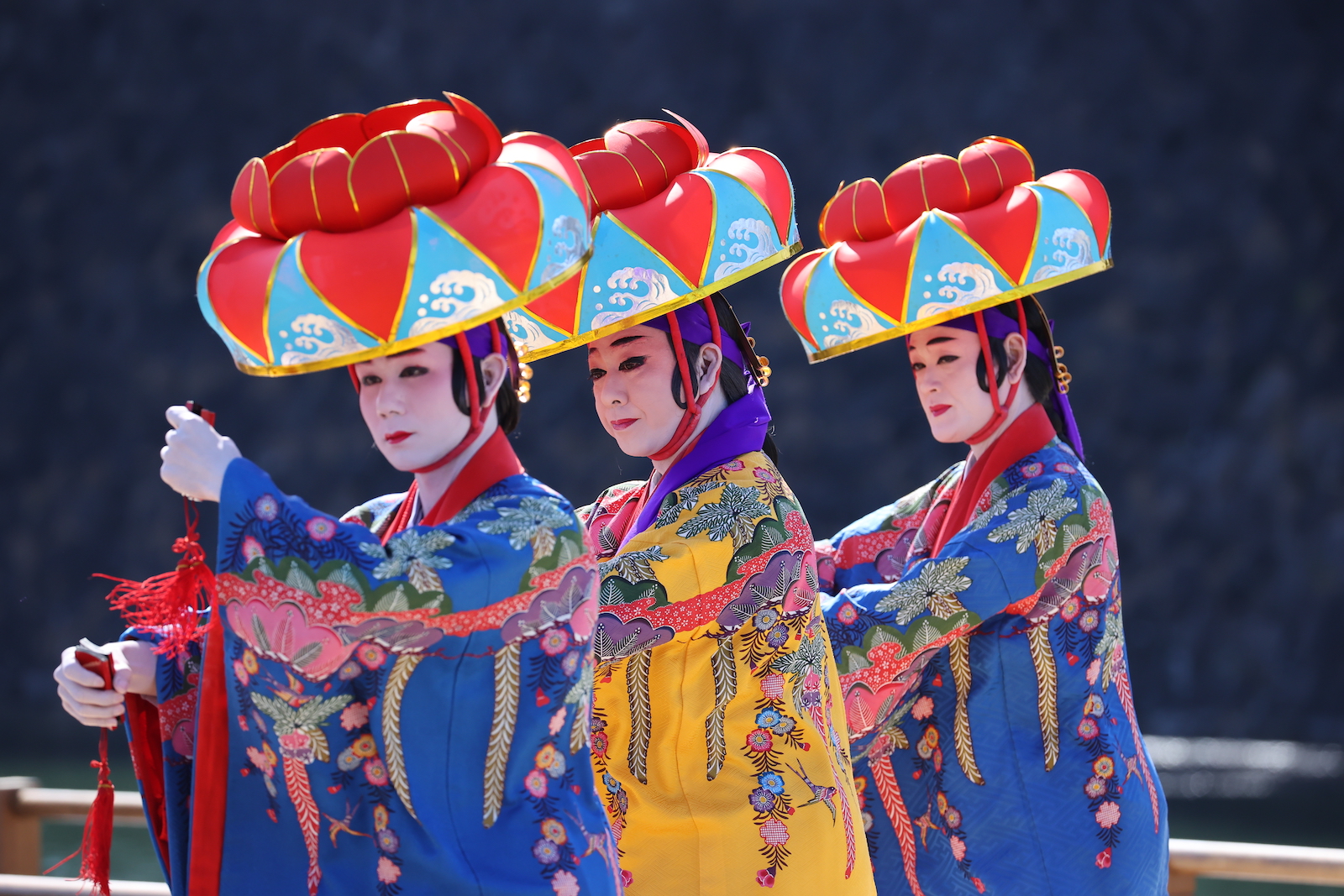On March 14, the Japan Cultural Expo produced “Representation of Prayer” at the Kokyo Gaien National Garden. This compelling set of performances showcased Japanese traditional theater and dance from around the nation in the serene setting of the Imperial Palace Garden.
The program was part of a larger exhibition the organization is presenting in Japan to give audiences an opportunity to see many kinds of Japanese arts. On February 28 the Expo held a showcase of Japanese traditional music at the National Theatre. Other events in the series include the Tokyo Art Fair (March 18-21); Meiji Jingu Forest Festival of Art (March 20-31); the Kabuki performance “Toki wa Ima Kikyo no Hataage” (March 4-27); and the Great Yokai Yammit (November 6, 2020 – March, 2021). Notable past events were the Appreciating Ainu Culture Project (September 2019 – October 2020) and the Kuma Kengo exhibition (Kochi: November 3, 2020 – January 3, 2021; Nagasaki: January 22 – March 28, 2021). See the below Expo link for details on how to attend any of these continuing shows.
Yumi Ennyu, the Executive Director, Japan Cultural Expo, explained the overall initiative: “The Japan Cultural Expo is a nationwide project led by the Agency for Cultural Affairs and the Japan Arts Council, in collaboration with the government, private organizations and NPOs, as a core part of the cultural program for the 2020 Tokyo Olympic and Paralympic Games.
“Throughout the year, art exhibitions, stage performances and art festivals that embody the aesthetics of Japan are held across the country, with a common theme of how nature has been considered and expressed in art from the Jomon period 10,000 years ago to the present day.”
About 250 people attended the exhibition on March 14 and an extensive production team captured the proceedings for streaming for those not fortunate enough to get to view the work live. Tickets to the show can be found at the link below and it will stream online until March 30.
Okinawan Onna Odori Photo: Japan Arts Council
The performances can be broken down into four general parts. They started with two Okinawan dances, including Onna Odori and Nise Odori and moved into a Maibayashi (an extracted section of a Noh play) piece called “Iwafune” (The Stone Ship). The third part was a Kyogen performance called “Kusabira” (Mushrooms) and then the final Noh excerpt called “Shakkyo” (The Stone Bridge) was the finale.
The day started with the Ryukyuan dances from Okinawa, representing a prayer for reconstruction of the Shuri Castle in Naha, tragically destroyed by fire in 2019. Traditionally Ryukyu emissaries on their way to Edo performed these dances. In the spirit of prayer the dancers recreated the pieces as they were performed during the Edo Period. The Onna Odori featured extremely colorful kimono and uniquely-shaped headdress called Hanagasa. The movement was slow, graceful and mesmerizing, a perfect way to open the show. Next, Nise Odori presented a male dance that is traditionally used to banish evil spirits and bring good harvests.
The work “Iwafune” alludes to the trade between China and Japan in the Muromachi period (14th – 16th century) and features an impressive dragon deity that protects a sacred stone boat.
The Kyogen (a form of traditional Japanese comic theater) piece “Kusabira” brought considerable levity to the proceedings. A householder troubled by strange and fast-growing mushrooms in his yard asks a Buddhist priest to rid him of the menace by prayer. But the more the holy man prays the faster, bigger and more aggressive the mushrooms get. Finally the colorfully costumed shrooms take over in a denouement of droll theater.

Noh piece “Shakkyo” Photo: Japan Arts Council
Arguably the most powerful work was “Shakkyo,” a parable about a priest trying to cross a stone bridge. As the monk tries to go across guardian lions (in spectacular dress) appear, as on the other side is the Buddhist Pure Land of Monju Bosatsu (a Bodhisattva which personifies wisdom and represents Buddhist law). The lions dance in inventive and alluring ways, twisting their torsos and shaking their brilliant manes. These series of movements are unique to this piece in Noh theater. This performance, with dramatic dancing and costumes, was particularly affecting as the Nijubashi bridge of the Imperial Palace loomed behind the stage, representing the titular bridge.
In all, the presentations wove together the traditional arts with Japanese spirituality and, in some cases, put them in a modern context. The intensity of subtlety of the movements were affecting and represented the core of the long tradition of Japanese performing arts.
Link to “Representation of Prayer” — https://japanculturalexpo.bunka.go.jp/en/rop/#
Tickets for “Representation of Prayer”– https://japanculturalexpo.zaiko.io/e/representation-of-prayer
Japan Cultural Expo and its events — https://japanculturalexpo.bunka.go.jp/en/
© Japan Today

